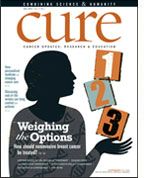Publication
Article
CURE
Tough Talk: Preparing for End of Life
Author(s):
Discussing end-of-life care can help ensure a dignified death.
When it’s clear that further therapy would do more harm than good, the best decision is to stop treatment and focus on quality of life, comfort and dignity at life’s end,” says oncologist Richard Frank. “Incredible physical and emotional healing occurs during this time, and it is essential that a patient and his or her family are afforded the opportunity to experience these sacred moments.”
Talking about end-of-life and the patient’s wishes for when that time comes can open lines of communication and better enable patients to die with dignity.
A 2014 review of scientific literature clarified the best current practices to ensure that patients have a dignified death. These measures include using appropriate interventions for physical, psychological and spiritual support not only for patients but also for their family members. But if patients and their caregivers avoid or do not know the fact that death is near, there is a chance that important, healing conversations about life’s end will not occur.
Frank, a hematologist and medical director of Mid-Fairfield Hospice in Wilton, Conn., says he became passionate about end-of-life discussions during his oncology fellowship.
“People were told there was nothing more that could be done—to go home and they would call hospice. In some instances, the doctor didn’t even see them,” Frank says. “I hated seeing that.”
Frank believes that it is the physician’s responsibility to inform the patient’s family that life-prolonging measures may not be in the patient’s best interest because the negative consequences may vastly outweigh the slim chance of helping.
While the number of hospice programs has increased, according to the National Consensus Project for Quality Palliative Care, the percentage of cancer patients who used hospice declined by a third between 1998 and 2007. One potential reason: a lack of understanding about the purpose of end-of-life care. Consider the results of a 2012 study published in The New England Journal of Medicine. A team led by researchers from the Dana-Farber Cancer Institute in Boston found that 70 percent of patients with end-stage lung cancer and 80 percent of patients with terminal colorectal cancer had “inaccurate expectations” that the chemotherapy they were receiving might cure their cancer, a misunderstanding that “could represent an obstacle to optimal end-of-life planning and care.”
This lack of awareness about the purpose of end-oflife care could be why many patients enter hospice care too late—often within days of death—and many others die in hospital intensive care units despite the fact that most would prefer to die at home. A study published in the Journal of Clinical Oncology in 2010 showed that patients who died in an ICU or at a hospital had a worse quality of life than patients who died at home with hospice. Moreover, caregivers of hospitalized patients were “at increased risk for developing psychiatric illness.”
The National Comprehensive Cancer Network’s guidelines for palliative care recommend that end-of-life discussions occur with all patients when it is clear they have less than a year to live, which allows them time to talk to their family and with healthcare providers about an array of concerns, such as the fear of dying, understanding their prognosis, achieving end-of-life goals and physical needs. But for many patients, this is not happening.
The Elephant in the Room
“If families don’t know their loved one is dying, how do they do the right thing?” asks Kathy Plakovic, a nurse practitioner at the University of Illinois Hospital in Chicago.
Plakovic says that when treatment stops working and the patient wants to know what else is available: “Seldom does anyone say, ‘This is advanced cancer and we cannot cure you. You will die of this disease.’ ”
Since these conversations are so rare, Plakovic says she usually sees families when their loved one is in the ICU and on some form of life support but “actively dying,” never having fully understood the inevitability of death.
As reality sets in, the conversations begin about what the loved one would want, she says. But unless the patient’s wishes are detailed in an advance directive and a medical power of attorney is in place to ensure someone will carry out those wishes, the patient’s desires for end-of-life care can be changed at any time by a family member or by someone on the medical team.
Plakovic says it’s not unusual for the family to come to an agreement about next steps and then have everything derailed by a relative who shows up and announces that the patient is a fighter and would want to do everything to live.
A death with dignity, she says, involves knowing what the patient wants and fulfilling those wishes, and it begins with conversations in the family and with the doctor and the hospital healthcare team. She says that patients often don’t understand palliative care and even associate it with a death sentence; these misconceptions are major barriers to achieving timely end-of-life discussions.
“Palliative care is defined as reducing suffering, whether physical, psychosocial or spiritual, regardless of where the patient is in their disease process,” Plakovic explains. As an example, she says, if a young woman with newly diagnosed breast cancer has intractable nausea and vomiting, the palliative care she receives will focus on symptom management. “It isn’t about death and dying.”
End-of-life care, she explains, is a type of palliative care, and because pain relief and other symptom management are frequently needed in advanced cancer, palliative care has become synonymous with end-of-life care, although it is available from the time of diagnosis.
Frank concedes that in his practice, where discussions about values and spirituality relevant to end-of-life begin early, patients and their families are often reluctant to talk about death, even when it is imminent.
“First there has to be an acknowledgement of the elephant in the room,” he says. “The patient is clearly deteriorating and is a far cry from their former self. They are succumbing to cancer. The doctor sees it, the family knows it, but they don’t want to talk about it as they continue to hope for something better.”
Communication and Caring
“I am in a grief support group, and I hear the regret from those who didn’t have the kind of conversations we did,” says Penny Pearlman. “I know that there was nothing left unsaid, and that gives me a lot of comfort.”
Pearlman and her husband, Bob Minicucci, began what she calls “tissue talks” soon after Minicucci learned he had a brain tumor in January 2013. They had filled out the advance directives and healthcare power of attorney when they completed their wills some 20 years before, Pearlman says. Shortly after he received his diagnosis, they updated their wills and all the relevant paperwork to ensure there would be no misunderstandings. Because it was a second marriage for both, they wanted all the paperwork completed so that children from their first marriages would never have to make those decisions.
“Because Bob had a glioblastoma, we knew the outcome would likely not be good,” Pearlman says, but she adds they decided to undergo treatment with hope of having a little more time. During his surgery, chemotherapy and radiation, the couple began talking. At first, conversations were about his treatment, Pearlman says. Then they began using Five Wishes, a set of questions intended to prompt deeper discussion than those in the advance directive (visit AgingWithDignity.org/five-wishes.php).
“These talks were much more difficult because it was the nitty-gritty,” she says. “What he wanted for a memorial service. Did he want to be cremated or buried, and what kind of legacy he wanted to leave? But mostly we talked about our relationship and how much we meant to each other.” They talked about their travels and the party the year before when they celebrated his 70th birthday and their 20th anniversary. A few weeks before he died, her husband gave her what she calls a final gift. Despite having difficulty speaking, he was able to respond when she asked him if he was comfortable and at peace. “When I said that to him, he told me what I so needed to hear,” she recalls. “He said, clear as can be, ‘I am.’ ”
Minicucci died at home in February 2014, and Pearlman says she felt prepared. He had been in the care of the hospice team since mid- December, and Pearlman says she had been well educated by the hospice nurse about what dying looked like. One regret: She wishes she had been at his bedside when he died instead of sleeping across the room. She knew that he had died when their cat, which had been next to him in bed during his illness, came to her in the night.
“That cat had been glued to him for months, so I knew,” she says
Being Prepared
Plakovic says that all patients, upon entering the hospital, are asked if they have an advance directive and medical power of attorney. If they answer yes, they are then asked if they have the documents with them, and they seldom do. But hospital personnel rarely follow up, Plakovic says, meaning patients’ written wishes often aren’t included with their file. The use of electronic medical records might help with filing and searching for these documents more easily.
Discussions about the end of life should begin when the patient still feels well, Plakovic says. Today, there are books, questionnaires and even games to help families begin talking about end-of-life wishes. Each state has different documents, and many offer their own options. Once the questions are answered and the medical power of attorney is granted, it is essential that the advance directive and any other pertinent documents be given to family members and medical health professionals, Plakovic says. Because many patients have multiple healthcare providers, they should see that these documents are placed in every file that exists for their care. Even then, she says, patients need to be aware that the advance directive can be ignored, particularly when no one has said the patient is actively dying.
[Caregivers Can Benefit from Early Intervention]
Plakovic says that if the caregiver who has the medical power of attorney doesn’t understand that the patient is dying, it’s possible that the patient’s decisions could be overturned by family members or by well-meaning doctors. Some physicians act out of an abundance of caution, she explains, “so if the family expresses a strong desire, they will go along. This is where the ethics committee comes in.”
If the caregivers don’t know the patient is close to death, they may ask for measures that the patient clearly did not want. In such cases, it is good to have a strong advocate who has been granted the medical power of attorney, she says, adding that the person should be chosen carefully and be willing to follow the patient’s wishes in times of crisis. Plakovic gives an example from her own life.
“When it came time for me to do my healthcare power of attorney, I didn’t name my husband and it caused some marital strife,” Plakovic recalls. “He said, ‘Why wouldn’t you name me? I am your husband.’ ” She explained to him that were she on a ventilator after an accident and had no hope for recovery, he would do everything to keep her alive. “He finally came around and told me I was right. He was too emotionally invested to make the decision, so I named my sister.”
Talking Points:
> Discussions about end-of-life care should begin when the patient still feels well.
> Patients should grant the medical power of attorney to someone who will be a strong advocate.





